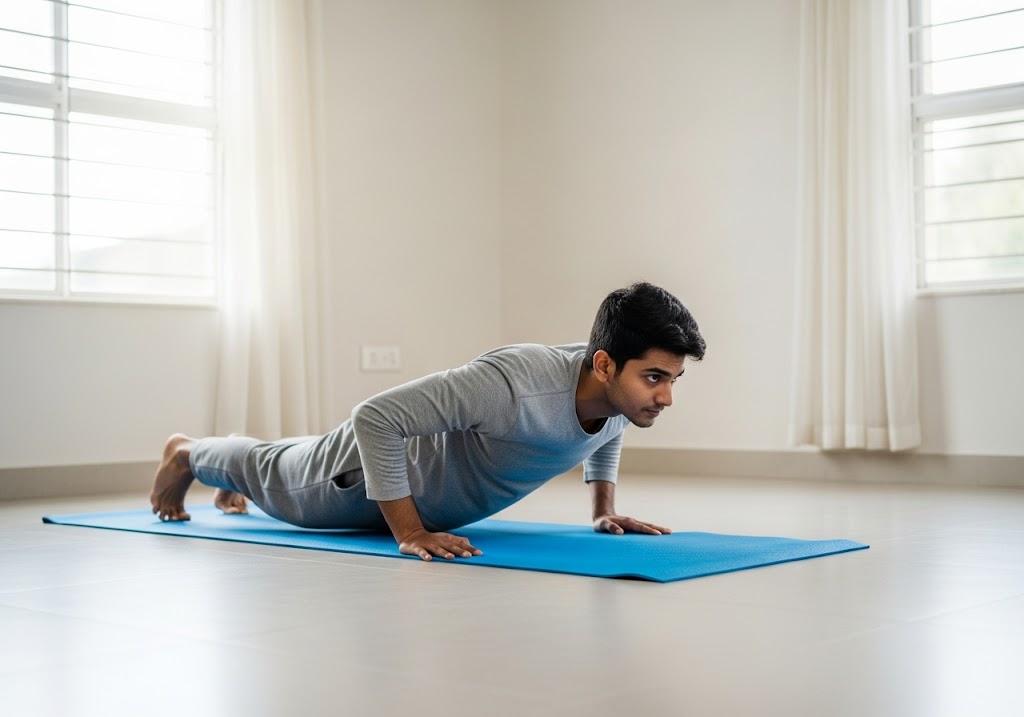Should you exercise with sore muscles? Yes. You can exercise with mild to moderate muscle soreness (1-6/10 intensity) by reducing workout intensity 30-50%, but avoid exercise with severe soreness (7+/10) or sharp pain that may indicate injury.
Wondering if you should you exercise with sore muscles after yesterday’s intense workout? This common fitness dilemma affects everyone from beginners to advanced athletes who push their limits. Understanding when exercising with sore muscles is safe versus when rest is necessary can make the difference between progress and injury. The answer isn’t simply yes or no – it depends on the type, intensity, and location of your muscle soreness.
Table of Contents
Is it Bad to Work Out When You’re Sore?
Working out when you’re sore isn’t inherently bad, but the answer to should you exercise with sore muscles depends on several important factors. Mild to moderate muscle soreness from previous workouts is generally safe to train through with proper modifications, while severe soreness or sharp pain requires rest and recovery.
The type of soreness matters significantly when deciding should you exercise with muscle soreness. Delayed Onset Muscle Soreness (DOMS) typically peaks 24-72 hours after exercise and feels like a deep, aching sensation in the muscles. This type of soreness usually indicates normal muscle adaptation and doesn’t necessarily require complete rest from exercise.
| Soreness Level | Safety to Exercise | Modifications Needed | Recommended Action |
|---|---|---|---|
| Mild (1-3/10) | Safe | Light intensity | Continue with caution |
| Moderate (4-6/10) | Generally safe | Significant modifications | Reduce intensity |
| Severe (7-8/10) | Risky | Major changes required | Consider rest day |
| Extreme (9-10/10) | Unsafe | No exercise | Complete rest needed |
For those beginning their fitness journey, how to start calisthenics provides excellent foundation training that minimizes excessive soreness while building strength progressively.

When it’s Safe to “Push Through the Pain” and When it Isn’t
Determining when it’s safe to push through discomfort versus when to rest is crucial for anyone wondering should you exercise with sore muscles. Safe scenarios include mild muscle stiffness that improves with movement, general fatigue without sharp pain, and soreness isolated to specific muscle groups that allows training of unaffected areas.
Unsafe scenarios that require rest include sharp or stabbing pain, soreness accompanied by swelling or bruising, pain that worsens with movement, and any discomfort that affects normal daily activities. These symptoms suggest potential injury that needs proper healing time before resuming exercise safely.
Find out the benefits of both in this detailed comparison: Cold Shower vs Hot Shower and choose what suits your body best.
Is it Ever Safe to Keep Exercising Through Pain?
The question of whether you should exercise with sore muscles through pain requires careful distinction between different types of discomfort. Normal exercise discomfort includes muscle fatigue during workouts, mild burning sensations during high-intensity exercise, and general muscle stiffness after training that typically indicates adaptation rather than harm.
Concerning pain signals include sharp, stabbing sensations, pain that doesn’t improve with rest, swelling or visible bruising, and discomfort that interferes with normal movement patterns. These symptoms suggest potential injury and warrant medical evaluation rather than continued exercise through potentially dangerous conditions.
For comprehensive bodyweight training that respects recovery needs, bodyweight exercises for beginners provides gentle introduction to exercise that minimizes excessive soreness.

How Working Out Causes Soreness?
Understanding how exercise creates muscle soreness helps answer whether you should you exercise with sore muscles safely. Exercise-induced soreness results from microscopic damage to muscle fibers, inflammation responses, and metabolic byproduct accumulation that occurs during challenging physical activity for muscle adaptation.
| Soreness Cause | Mechanism | Timeline | Severity | Recovery Strategy |
|---|---|---|---|---|
| Mechanical Stress | Muscle fiber tears | 12-48 hours | Moderate-High | Light movement |
| Metabolic Stress | Byproduct accumulation | Immediate-6 hours | Low-Moderate | Hydration, rest |
| Inflammatory Response | Immune cell activation | 24-72 hours | High | Anti-inflammatory foods |
| Eccentric Contractions | Lengthening under load | 24-48 hours | High | Gentle stretching |
| Novel Exercise | Unaccustomed movement | 12-72 hours | Variable | Progressive loading |
Delayed Onset Muscle Soreness (DOMS) – Muscle Pain Delayed
Delayed Onset Muscle Soreness (DOMS) typically appears 12-24 hours after exercise and peaks between 24-72 hours post-workout. This delayed timeline is important when considering should you exercise with muscle soreness, as immediate post-exercise feelings may not reflect how you’ll feel the next day.
The delayed nature of DOMS occurs because inflammatory responses and cellular repair processes take time to develop. Initial exercise may feel fine, but the real soreness impact becomes apparent hours later when inflammatory mediators reach peak levels in the affected muscles.
| Timeline | Soreness Level | Exercise Decision | Recommended Approach |
|---|---|---|---|
| 0-12 hours | Minimal | Generally safe | Normal training |
| 12-24 hours | Increasing | Monitor closely | Light activity |
| 24-48 hours | Peak soreness | Careful assessment | Modified training |
| 48-72 hours | Peak/declining | Recovery focus | Gentle movement |
| 72+ hours | Declining | Gradual return | Progressive loading |
For structured training that accounts for recovery needs, basic calisthenics workout provides progressive routines that balance challenge with appropriate recovery time.

Exercising When Your Body Is Sore
Making the decision about should you exercise with sore muscles requires evaluating multiple factors including soreness intensity, location, and your overall energy levels. Smart training decisions during soreness can actually promote recovery while maintaining fitness momentum through appropriate exercise modifications and intensity adjustments.
Active recovery through light exercise often proves more beneficial than complete rest for mild to moderate soreness. Gentle movement increases blood flow to sore muscles, delivers nutrients needed for repair, and helps clear metabolic waste products that contribute to discomfort and stiffness.
| Soreness Level | Exercise Recommendation | Intensity Modification | Duration Change |
|---|---|---|---|
| Mild (1-3/10) | Continue training | Reduce 10-20% | Normal length |
| Moderate (4-6/10) | Light activity | Reduce 30-50% | Shorten by 25% |
| Severe (7+/10) | Rest or gentle movement | Reduce 70%+ | Very short/rest |
How to Deal with Sore Muscles After Exercise?: Recovering After a Hard Workout
Proper recovery strategies significantly influence whether you should exercise with sore muscles the following day. Implementing effective recovery protocols immediately after intense workouts can minimize soreness severity and duration while preparing your body for subsequent training sessions through systematic recovery approaches.
Post-workout recovery begins immediately with proper cool-down activities including light movement and stretching. Nutrition timing plays a crucial role, with protein and carbohydrate consumption within 2 hours supporting muscle repair and glycogen replenishment for optimal adaptation and reduced soreness.
| Recovery Method | Timing | Duration | Primary Benefit |
|---|---|---|---|
| Cool-down | Immediately post-workout | 10-15 minutes | Gradual heart rate reduction |
| Protein intake | Within 2 hours | Ongoing | Muscle repair support |
| Quality sleep | Nightly | 7-9 hours | Growth hormone release |
For comprehensive recovery support, understanding what is foam rolling can help reduce muscle tension and promote better circulation for faster recovery.

Should You Exercise with Muscle Soreness? : Work Out Without Overdoing It
Learning to exercise appropriately when dealing with soreness prevents the cycle of excessive training, severe soreness, and forced rest days. Smart training during soreness focuses on maintaining movement while respecting your body’s current recovery status through strategic intensity and duration modifications.
Intensity modification is the most important factor when deciding should you exercise with muscle soreness. Reducing training intensity by 30-50% allows continued movement without overwhelming already stressed muscles, promoting recovery while maintaining exercise habits and psychological momentum.
| Modification Type | Normal Training | Sore Muscle Training | Adjustment Percentage |
|---|---|---|---|
| Intensity | High | Low-Moderate | Reduce 30-50% |
| Duration | Full length | Shortened | Reduce 25-40% |
| Resistance | Heavy | Light | Reduce 40-60% |
For those pursuing advanced training, advanced calisthenics routine demonstrates how to progress systematically while managing recovery demands effectively.
What are the Benefits of Exercise with Sore Muscles?
Understanding the potential benefits helps answer whether you should you exercise with sore muscles in your specific situation. Light exercise during mild soreness can actually promote recovery through increased blood flow, nutrient delivery, and metabolic waste removal from affected muscles.
Active recovery through gentle exercise often reduces soreness duration compared to complete rest. Movement stimulates circulation, which helps deliver oxygen and nutrients needed for muscle repair while removing inflammatory byproducts that contribute to discomfort.
- Improved Blood Flow: Light exercise increases circulation to sore muscles, promoting nutrient delivery and waste removal
- Maintained Exercise Habit: Consistent activity helps preserve training momentum and psychological motivation
- Enhanced Flexibility: Gentle movement and stretching can reduce stiffness associated with muscle soreness
- Faster Recovery: Active recovery often proves more effective than complete rest for mild to moderate soreness
- Mental Benefits: Staying active can improve mood and prevent the frustration of forced inactivity
- Movement Quality: Light exercise helps maintain movement patterns and prevents excessive stiffness

What are the Risks of Exercise with Sore Muscles?
Understanding potential risks is equally important when deciding should you exercise with sore muscles. Inappropriate exercise during significant soreness can lead to overuse injuries, extended recovery periods, and decreased training quality that ultimately hinders fitness progress.
Overuse injuries become more likely when exercising through severe soreness, as fatigued muscles cannot provide normal joint protection and movement control. This increased injury risk makes rest more valuable than continued training during significant discomfort.
Compensation patterns develop when sore muscles cannot function normally, leading to altered movement quality that can stress other areas of the body. These compensations may create new problems in previously unaffected muscles and joints.
| Risk Factor | Consequences | Prevention Strategy |
|---|---|---|
| Overuse Injury | Tendon/ligament damage | Respect pain signals |
| Compensation Patterns | Secondary injuries | Maintain movement quality |
| Extended Recovery | Longer soreness duration | Appropriate rest timing |
| Decreased Performance | Poor training quality | Intensity modifications |
| Psychological Stress | Motivation loss | Realistic expectations |
For structured training that balances intensity with recovery, full body calisthenics workout provides comprehensive routines designed to minimize excessive soreness while maximizing results.

Injury vs. Soreness
Distinguishing between normal muscle soreness and potential injury is crucial when deciding should you exercise with sore muscles. This differentiation determines whether continued exercise is safe or whether medical evaluation and complete rest are necessary for proper healing and recovery.
| Characteristic | Normal Soreness | Potential Injury |
|---|---|---|
| Onset | Gradual (12-24 hours) | Immediate or sudden |
| Pain Type | Dull, aching | Sharp, stabbing |
| Distribution | Symmetrical | Often asymmetrical |
| Movement Response | Improves with activity | Worsens with movement |
| Duration | 3-5 days | Persistent (5+ days) |
| Location | Entire muscle group | Localized, specific area |
| Daily Activities | Minimally affected | Significantly impaired |
| Response to Rest | Gradual improvement | Little to no improvement |
Tips for Preventing Soreness
Preventing excessive soreness makes the question of should you exercise with muscle soreness less frequent and challenging. Implementing proper training strategies, recovery protocols, and progression principles significantly reduces soreness severity while maintaining training effectiveness and consistency.
- Gradual Progression: Increase training loads by no more than 10% per week to allow muscles to adapt without excessive damage
- Proper Warm-up: Dynamic warm-ups that gradually increase heart rate and muscle temperature prevent excessive soreness
- Post-Exercise Cool-down: Light movement and gentle stretching immediately after training begin the recovery process effectively
- Consistent Training Schedule: Regular moderate exercise produces less soreness than occasional very intense sessions
- Adequate Hydration: Proper fluid intake supports cellular function and helps remove metabolic waste products
- Quality Sleep: 7-9 hours of sleep provides optimal environment for muscle repair and recovery processes
- Balanced Nutrition: Adequate protein and anti-inflammatory foods support muscle repair and reduce soreness intensity
- Progressive Loading: Avoid dramatic increases in exercise intensity, duration, or frequency to prevent excessive muscle damage
For effective warm-up strategies, warm up exercises for beginners provides comprehensive preparation routines that help prevent excessive muscle soreness.

What Causes Muscle Soreness After a Workout?
Understanding the physiological mechanisms behind exercise-induced soreness helps make informed decisions about whether you should exercise with sore muscles. Multiple factors contribute to post-exercise discomfort, each with different implications for recovery and subsequent training decisions based on individual response patterns.
Eccentric muscle contractions create the most soreness, where muscles lengthen under tension during activities like downhill running or lowering weights slowly. Mechanical stress creates microscopic tears triggering inflammatory responses, while novel exercise patterns produce more soreness than familiar movements due to unaccustomed stress patterns.
| Soreness Factor | Description | Timeline | Severity Level |
|---|---|---|---|
| Eccentric Contractions | Muscle lengthening under load | 24-48 hours | High |
| Mechanical Stress | Microscopic muscle tears | 12-72 hours | Moderate-High |
| Inflammatory Response | Immune system activation | 24-48 hours | Variable |
| Novel Exercise | Unaccustomed movement patterns | 12-72 hours | High |
For high-intensity training options that can be modified based on soreness levels, hiit workout in mumbai provides structured routines that can be adapted to current fitness status.

The 5 Best Ways to Relieve Sore Muscles
Effective soreness relief strategies help determine whether you should exercise with muscle soreness by reducing discomfort and promoting faster recovery. These evidence-based approaches address different aspects of exercise-induced soreness for comprehensive relief.
1. Light Active Recovery
Gentle movement increases blood flow to sore muscles without adding excessive stress. Walking, easy swimming, or light cycling promote nutrient delivery and waste removal while maintaining exercise habits during recovery periods.
2. Proper Hydration and Nutrition
Adequate water intake supports cellular function and waste removal, while protein consumption provides building blocks for muscle repair. Anti-inflammatory foods like berries, fatty fish, and leafy greens may help reduce soreness intensity.
3. Quality Sleep
Sleep provides the optimal environment for muscle repair and recovery. Growth hormone release during deep sleep stages supports tissue regeneration, making 7-9 hours of quality sleep essential for soreness resolution.
4. Gentle Stretching and Mobility Work
Static stretching and mobility exercises can reduce muscle stiffness and improve range of motion. Focus on gentle, sustained stretches rather than aggressive stretching that might worsen muscle damage.
5. Heat and Cold Therapy
Alternating heat and cold applications can provide soreness relief through different mechanisms. Heat increases blood flow and reduces stiffness, while cold therapy may reduce inflammation and numb pain sensations.
| Relief Method | Best Timing | Duration | Benefits | Considerations |
|---|---|---|---|---|
| Light Movement | Day after exercise | 20-30 minutes | Improved circulation | Avoid intensity |
| Hydration | Continuous | Throughout day | Cellular function | 8-10 glasses daily |
| Sleep | Nightly | 7-9 hours | Tissue repair | Consistent schedule |
| Stretching | Post-exercise | 10-15 minutes | Reduced stiffness | Gentle approach |
| Heat/Cold | As needed | 15-20 minutes | Pain relief | Avoid extremes |
For gentle movement options that promote recovery, somatic pilates offers mindful movement practices that can help reduce muscle tension and promote relaxation.
Should You Exercise Different Muscle Groups When Sore?
Training different muscle groups while some areas are sore represents a practical solution to the question should you exercise with sore muscles. This approach allows continued training while providing adequate recovery time for affected muscles through strategic exercise selection and rotation.
Split training routines become particularly valuable when dealing with localized soreness, allowing upper body workouts while legs recover or vice versa. Unilateral training and core exercises often remain possible even when limbs are sore, maintaining fitness while promoting recovery through increased circulation to unaffected areas.
For targeted training approaches, unilateral exercises provides single-limb movements that can work around localized soreness effectively.

Creating a Smart Training Schedule Around Soreness
Developing a training schedule that accounts for normal soreness patterns helps answer should you exercise with muscle soreness proactively. Smart programming reduces the frequency of severe soreness while maintaining consistent training progress through strategic muscle group rotation and intensity management.
| Training Day | Intensity | Muscle Focus | Soreness Management | Expected Recovery |
|---|---|---|---|---|
| Monday | High | Upper Body | Fresh start | 48-72 hours |
| Tuesday | Moderate | Lower Body | Different groups | 24-48 hours |
| Wednesday | Low | Active Recovery | Promote circulation | Ongoing |
| Thursday | High | Upper Body | Recovered from Monday | 48-72 hours |
| Friday | Moderate | Lower Body | Light intensity | 24-48 hours |
| Saturday | Low | Full Body Stretch | Recovery preparation | Ongoing |
| Sunday | Rest | Complete Rest | Mental/physical recovery | Full restoration |
For comprehensive routine planning, calisthenics diet chart provides nutritional strategies that support recovery and training adaptation.
Should I Continue Exercise with Muscle Soreness: When to Seek Professional Help?
Certain soreness patterns and symptoms require professional evaluation rather than attempting to self-manage through continued exercise. Knowing when to seek help prevents minor issues from becoming serious injuries that require extended recovery periods and professional intervention for proper healing.
Persistent soreness lasting more than 7-10 days without improvement suggests potential injury or underlying issues requiring medical attention. Asymmetrical soreness affecting only one side, soreness with swelling or bruising, and functional limitations preventing normal daily activities indicate severity beyond normal exercise response requiring evaluation.
| Warning Sign | Description | Action Required | Urgency Level |
|---|---|---|---|
| Persistent Pain | 7+ days without improvement | Medical evaluation | Moderate |
| Asymmetrical Soreness | One-sided symptoms only | Professional assessment | Moderate |
| Swelling/Bruising | Visible tissue changes | Immediate medical attention | High |
| Functional Limitation | Unable to perform daily tasks | Medical evaluation | High |
For advanced training guidance that includes proper progression and recovery, calisthenics planche demonstrates how to build strength safely while managing training demands.
Conclusion
The question should you exercise with sore muscles doesn’t have a simple yes or no answer, as it depends on soreness type, intensity, and individual factors. Mild to moderate muscle soreness often allows modified exercise that can actually promote recovery, while severe soreness or injury-related pain requires rest and professional evaluation. The key is learning to distinguish between normal exercise adaptation and potentially harmful symptoms, then adjusting training accordingly. Whether you’re dealing with delayed onset muscle soreness or deciding how to exercise with sore muscles safely, listening to your body and implementing appropriate modifications ensures long-term training success. Smart training decisions during soreness periods can maintain fitness momentum while respecting your body’s recovery needs, ultimately leading to better results and fewer injuries over time.
Want to master the calisthenics handstand and take your skills to the next level? Whether you’re a beginner or pushing advanced skills, ISC – Indian School of Calisthenics offers expert guidance to help you master bodyweight training. Visit us at SRPF Ground, NH8, Goregaon (E), Mumbai – 400065. For class schedules, personalized coaching, or more details, call +91 77159 53218. Train smart, move better, and unlock your back strength with ISC.
Should You Exercise with Sore Muscles? – FAQs
Should I wait until my muscles aren’t sore to work out again?
No, mild to moderate soreness (1-6/10) typically allows modified exercise, while severe soreness (7+/10) requires rest until intensity decreases significantly.
Should I skip a workout if I’m sore?
Skip workouts only if soreness is severe (7+/10), accompanied by pain, or prevents normal movement; otherwise modify intensity and exercises.
Do sore muscles mean growth?
Soreness can indicate muscle adaptation but isn’t required for growth; consistent progressive training matters more than soreness presence.
Is it bad to workout while sore?
Working out while mildly sore isn’t bad if you modify intensity appropriately; severe soreness or pain requires rest.
Am I still gaining muscle if I’m not sore?
Yes, muscle growth occurs without soreness when progressive overload and adequate protein intake are maintained consistently over time.
Is soreness an indicator of a good workout?
Soreness can indicate muscle challenge but isn’t necessary for effective workouts; progressive overload is a better indicator.
Does soreness mean your muscles are still recovering?
Mild soreness may indicate ongoing recovery, but muscles can recover without soreness; severe soreness suggests incomplete recovery.
How long should I let my muscles heal before working out again?
Allow 48-72 hours for the same muscle group; train different muscles if some areas are still moderately sore.
Why am I still sore 4 days after working out?
Persistent soreness beyond 3-4 days may indicate excessive training, poor recovery, or potential injury requiring evaluation.
Should I train legs again if they are still sore?
Avoid training legs if significantly sore; wait until soreness reduces to mild levels or focus on upper body training.
Can I train a muscle again if it’s not sore?
Yes, absence of soreness doesn’t prevent training; allow 48-72 hours between intense sessions regardless of soreness levels.


